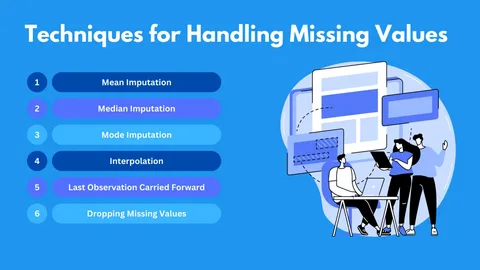Introduction
Data is rarely perfect. Real-world datasets often contain missing values due to errors in data collection, inconsistent reporting, or system limitations. Proper handling of missing data is vital for accurate analysis, as ignoring these gaps can lead to biased models, misleading insights, and flawed decision-making.
For students enrolled in a data scientist course in Bangalore, mastering the techniques of missing data handling—whether through deletion, imputation, or advanced strategies—is a fundamental step in building reliable data pipelines and predictive models. This article explores best practices, strategies, and considerations for managing missing data without using code, focusing on conceptual understanding and practical application.
Understanding Missing Data
Before addressing missing values, it is important to understand the nature and patterns of missing data. Missing data can be classified into:
- Missing Completely at Random (MCAR):
Data points are missing without any systematic pattern. For example, a survey respondent skips a question by chance. Handling MCAR is generally straightforward because the missingness does not bias the dataset. - Missing at Random (MAR):
Missingness depends on observed data but not on unobserved data. For instance, higher-income respondents might be less likely to report certain spending habits. Analytical methods can account for MAR using imputation strategies informed by other available variables. - Missing Not at Random (MNAR):
The missingness is related to the unobserved value itself. For example, people with very high incomes might deliberately omit this information. MNAR is the most challenging type, often requiring domain knowledge or modelling approaches to address.
Understanding these categories helps data scientists choose the most appropriate treatment for missing data, ensuring the robustness and reliability of analytical models.
Common Strategies for Handling Missing Data
Handling missing data requires a balance between maintaining dataset integrity and minimising information loss. The most widely used approaches include deletion and imputation.
1. Deletion Methods
Deletion methods remove observations or variables with missing values. This strategy is simple but can lead to loss of valuable information if overused.
- Listwise Deletion: Entire rows with any missing values are removed. This is suitable when the percentage of missing data is low and MCAR is assumed.
- Column Deletion: Variables with a high proportion of missing values are removed. This method is effective when certain features contribute little to the analysis or predictive model.
While deletion methods are straightforward, over-reliance on them can reduce statistical power, distort distributions, and compromise model accuracy.
2. Imputation Methods
Imputation replaces missing values with estimated or calculated values, preserving dataset size and variability.
- Mean/Median Imputation: Replacing the missing values with the mean or median of the observed data is simple and effective for numerical variables, especially under MCAR assumptions.
- Mode Imputation: For categorical variables, missing values can be substituted with the most frequent category.
- Predictive Imputation: Advanced methods use correlations between variables to estimate missing values. For example, regression-based approaches predict missing values using other available features.
- Forward/Backwards Imputation: Common in time-series data, this method fills missing values using previous or subsequent observations.
Imputation maintains dataset size and can improve model stability, but improper imputation can introduce bias if the underlying assumptions are not carefully considered.
Best Practices for Handling Missing Data
To ensure high-quality data analysis, students and professionals should follow these best practices:
- Analyze Missingness: Evaluate the proportion and pattern of missing data before deciding on a handling strategy. Visualization and descriptive statistics can reveal trends and inform the approach.
- Document Decisions: Maintain clear records of why and how missing values were handled. This improves reproducibility and allows for review and auditing.
- Choose Context-Appropriate Methods: The selection between deletion, mean imputation, or predictive imputation depends on data type, missingness pattern, and downstream analysis.
- Assess Impact on Models: Evaluate how missing data handling affects model performance and statistical conclusions. Conduct sensitivity analyses when appropriate.
- Use Multiple Imputation if Necessary: In complex scenarios, multiple imputation generates several plausible datasets, combining results for robust inference.
Following these practices ensures that missing data treatment does not compromise the validity of analysis or predictive modelling.
Advanced Considerations
For learners in a data scientist course in Bangalore, understanding advanced strategies for missing data is critical:
- Domain Knowledge Integration: Leveraging domain expertise can guide imputation strategies, especially for MNAR cases.
- Probabilistic Imputation: Methods such as Bayesian imputation account for uncertainty in estimates, preserving variability in the dataset.
- Machine Learning-Based Imputation: Algorithms can predict missing values using patterns across features, enhancing accuracy over simple statistical methods.
- Data Augmentation: Generating synthetic observations based on existing patterns can mitigate information loss and improve model robustness.
These advanced techniques are increasingly relevant in real-world datasets, where missing data may not be random and simple strategies can fail.
Practical Implications
Handling missing data correctly has direct consequences for business insights, predictive modelling, and reporting:
- Model Accuracy: Proper imputation reduces bias and enhances the predictive capability of machine learning models.
- Decision-Making: Clean and complete datasets ensure that business decisions are based on reliable evidence.
- Regulatory Compliance: For sensitive domains like healthcare or finance, documented missing data handling is essential for audits and compliance.
- Data Integration: In multi-source analytics, aligning datasets and handling missing values consistently ensures coherent and interpretable results.
Mastering these techniques enables data scientists to handle real-world datasets effectively, a skill emphasised in a data scientist course in Bangalore.
Conclusion
Missing data is an inevitable challenge in data science. The choice between deletion, simple imputation, and advanced strategies must consider the type and pattern of missingness, the dataset’s characteristics, and the objectives of analysis.
For students pursuing a data scientist course in Bangalore, understanding and applying these principles is fundamental for building reliable, robust, and interpretable analytics pipelines. Correct handling of missing data preserves information, minimises bias, and ensures that analytical insights accurately reflect reality.
By integrating best practices, advanced imputation strategies, and careful evaluation, data scientists can transform incomplete datasets into actionable intelligence, driving informed decision-making and maintaining the integrity of their analytical workflows.

